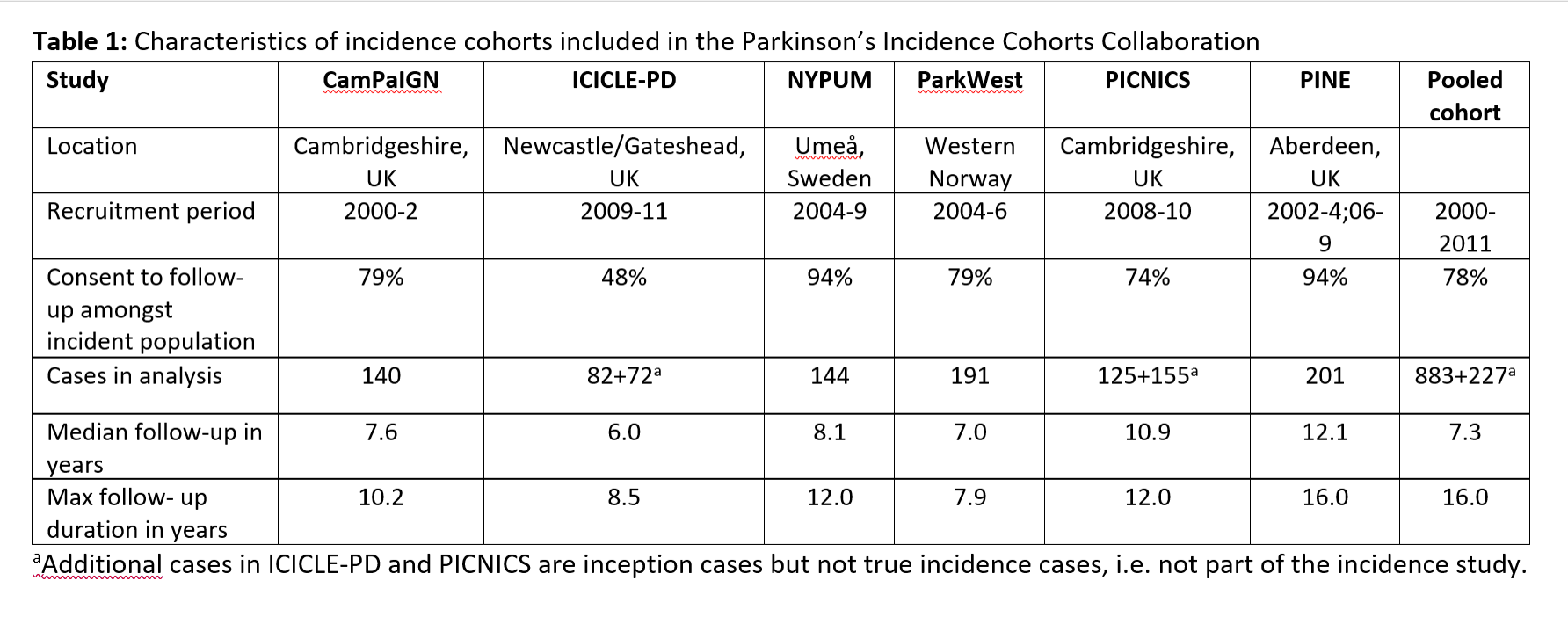Category: Epidemiology
Objective: To (i) identify all incidence cohorts of Parkinson’s disease (PD) with long-term follow up and (ii) pool data from these cohorts to study PD prognosis with low risk of selection bias.
Background: Robust data about prognosis (disease progression) is important to: inform people with PD how they may be affected; identify factors that influence prognosis (especially those that may be modifiable); make clinical trial design more efficient; and facilitate personalised medicine. Most prognosis studies in PD have used cohorts from specialist clinics, which under-represent the old and frail, leading to selection bias and over-optimistic estimates of overall prognosis.
Incidence cohorts begin by identifying all new cases of PD in a defined population and time period (an incidence study) and follow up these cases. Such cohorts are representative of the population with PD and thus more reliable estimates of prognosis than other study designs. Individual incidence cohorts have been small, so pooling data from existing cohorts enables analysis with greater statistical power.
Method: We performed a systematic review of worldwide incidence studies in PD[1] and identified those with long-term follow-up. After an initial meeting of the principal investigators, we initiated a collaboration agreement between those studies, standardised data, and established a pooled database with baseline (close to diagnosis) and follow-up data from these incidence studies. Several collaborative projects have been published using this database and others are in progress.
Results: We identified six incidence cohorts with long-term follow-up, all in Northern Europe: CamPaIGN and PICNICS (Cambridge, UK), ICICLE-PD (Newcastle, UK), NYPUM (Umeå, Sweden), ParkWest (Western Norway), PINE (Aberdeen, UK)[table1]. These studies sought to identify all new cases of PD in the population using community-based case ascertainment and invited cases to consent to long-term follow-up. 883 incident patients are followed-up in these cohorts, supplemented by 227 inception patients recruited outside the formal incidence period in two studies. 8-16 years’ follow-up are available. Pooled data common to all these studies include demographic data, genetic data, serial UPDRS/MDS-UPDRS, serial MMSE, and dementia and death outcomes.
Conclusion: We have developed a pooled dataset of incidence cohorts to study prognosis in PD with low risk of selection bias.
References: [1]Macleod AD, Henery R, Nwajiugo PC, Scott NW, Caslake R, Counsell CE. Age-related selection bias in Parkinson’s disease research: are we recruiting the right participants? Parkinsonism Relat Disord 2018; 55: 128-133.
To cite this abstract in AMA style:
A. Macleod, J. Maple-Grødem, M. Camacho, R. Lawson, D. Bäckström, A. Yarnall, C. Williams-Gray, G. Alves, O. Tysnes, L. Forsgren, C. Counsell. The Parkinson’s Incidence Cohorts Collaboration (PICC): an international collaboration of incident PD cohorts [abstract]. Mov Disord. 2022; 37 (suppl 2). https://www.mdsabstracts.org/abstract/the-parkinsons-incidence-cohorts-collaboration-picc-an-international-collaboration-of-incident-pd-cohorts/. Accessed November 8, 2025.« Back to 2022 International Congress
MDS Abstracts - https://www.mdsabstracts.org/abstract/the-parkinsons-incidence-cohorts-collaboration-picc-an-international-collaboration-of-incident-pd-cohorts/

